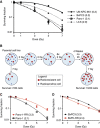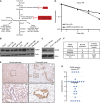Unbiased analysis of pancreatic cancer radiation resistance reveals cholesterol biosynthesis as a novel target for radiosensitisation
- PMID: 25025965
- PMCID: PMC4453840
- DOI: 10.1038/bjc.2014.385
Unbiased analysis of pancreatic cancer radiation resistance reveals cholesterol biosynthesis as a novel target for radiosensitisation
Abstract
Background: Despite its promise as a highly useful therapy for pancreatic cancer (PC), the addition of external beam radiation therapy to PC treatment has shown varying success in clinical trials. Understanding PC radioresistance and discovery of methods to sensitise PC to radiation will increase patient survival and improve quality of life. In this study, we identified PC radioresistance-associated pathways using global, unbiased techniques.
Methods: Radioresistant cells were generated by sequential irradiation and recovery, and global genome cDNA microarray analysis was performed to identify differentially expressed genes in radiosensitive and radioresistant cells. Ingenuity pathway analysis was performed to discover cellular pathways and functions associated with differential radioresponse and identify potential small-molecule inhibitors for radiosensitisation. The expression of FDPS, one of the most differentially expressed genes, was determined in human PC tissues by IHC and the impact of its pharmacological inhibition with zoledronic acid (ZOL, Zometa) on radiosensitivity was determined by colony-forming assays. The radiosensitising effect of Zol in vivo was determined using allograft transplantation mouse model.
Results: Microarray analysis indicated that 11 genes (FDPS, ACAT2, AG2, CLDN7, DHCR7, ELFN2, FASN, SC4MOL, SIX6, SLC12A2, and SQLE) were consistently associated with radioresistance in the cell lines, a majority of which are involved in cholesterol biosynthesis. We demonstrated that knockdown of farnesyl diphosphate synthase (FDPS), a branchpoint enzyme of the cholesterol synthesis pathway, radiosensitised PC cells. FDPS was significantly overexpressed in human PC tumour tissues compared with healthy pancreas samples. Also, pharmacologic inhibition of FDPS by ZOL radiosensitised PC cell lines, with a radiation enhancement ratio between 1.26 and 1.5. Further, ZOL treatment resulted in radiosensitisation of PC tumours in an allograft mouse model.
Conclusions: Unbiased pathway analysis of radioresistance allowed for the discovery of novel pathways associated with resistance to ionising radiation in PC. Specifically, our analysis indicates the importance of the cholesterol synthesis pathway in PC radioresistance. Further, a novel radiosensitiser, ZOL, showed promising results and warrants further study into the universality of these findings in PC, as well as the true potential of this drug as a clinical radiosensitiser.
Figures




References
-
- Andrianifahanana M, Agrawal A, Singh AP, Moniaux N, van Seuningen I, Aubert JP, Meza J, Batra SK. Synergistic induction of the MUC4 mucin gene by interferon-gamma and retinoic acid in human pancreatic tumour cells involves a reprogramming of signalling pathways. Oncogene. 2005;24 (40:6143–6154. - PubMed
-
- Asiyanbola B, Gleisner A, Herman JM, Choti MA, Wolfgang CL, Swartz M, Edil BH, Schulick RD, Cameron JL, Pawlik TM. Determining pattern of recurrence following pancreaticoduodenectomy and adjuvant 5-flurouracil-based chemoradiation therapy: effect of number of metastatic lymph nodes and lymph node ratio. J Gastrointest Surg. 2009;13 (4:752–759. - PubMed
-
- Boothman DA, Greer S, Pardee AB. Potentiation of halogenated pyrimidine radiosensitizers in human carcinoma cells by beta-lapachone (3,4-dihydro-2,2-dimethyl-2H-naphtho[1,2-b]pyran- 5,6-dione), a novel DNA repair inhibitor. Cancer Res. 1987;47 (20:5361–5366. - PubMed
Publication types
MeSH terms
Substances
Grants and funding
LinkOut - more resources
Full Text Sources
Other Literature Sources
Medical
Molecular Biology Databases
Miscellaneous

